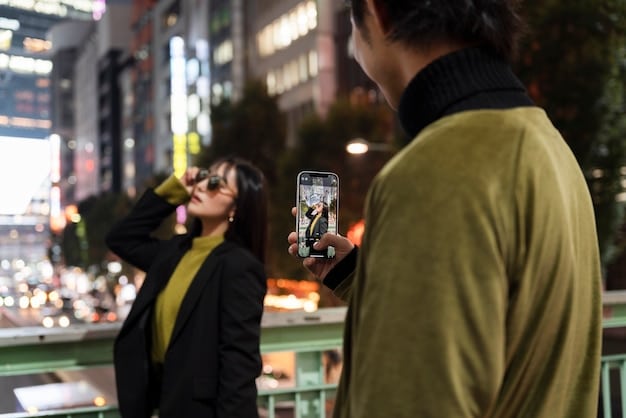Korean Drama Product Placement: Spotting Subtle Ads & Impact on US Consumers

Korean drama product placement, often subtly integrated, significantly influences US consumer behavior by showcasing brands in aspirational contexts, fostering familiarity, and driving purchase intent for featured goods.
The global phenomenon of K-dramas has captivated audiences worldwide, extending far beyond South Korea’s borders, especially in the United States. Beyond their compelling narratives and charismatic stars, these shows have become potent vehicles for brand promotion. This article delves into the intricate world of Korean Drama Product Placement: Spotting the Subtle Ads and Analyzing Their Impact on US Consumers, exploring how brands strategically embed themselves within beloved storylines and the profound effect this has on American purchasing habits.
The Art of Subtle Integration: Decoding K-Drama Product Placement
Korean dramas are renowned for their seamless integration of products, often blurring the lines between storytelling and advertising. Unlike overt commercial breaks in Western television, K-drama product placement, or PPL (Product Placement), is typically woven into the narrative fabric, making it feel less intrusive and more organic. This subtle approach contributes significantly to its effectiveness, as viewers perceive the products as part of the characters’ authentic lives rather than mere advertisements. The objective is to make the product feel indispensable or desirable within the aspirational lifestyle portrayed in the drama.
Evolution of K-Drama PPL
The evolution of PPL in K-dramas has been remarkable, transitioning from simple background appearances to integral plot devices. Initially, brands might have appeared incidentally, perhaps a character drinking a specific brand of coffee. However, as the industry recognized the immense marketing potential, PPL became more sophisticated. Now, entire scenes might revolve around a specific product, highlighting its features and utility in a natural, narrative-driven manner. This shift reflects a deeper understanding of audience engagement and the power of narrative immersion.
Brands pay considerable sums for these placements, understanding that the emotional connection viewers form with characters can transfer to the products they use. From luxury cars driven by leading men to the specific makeup worn by the female protagonists, every detail is meticulously planned. This strategic placement ensures maximum visibility while maintaining the entertainment value of the show. The goal is to create a positive association, implying that using these products can elevate one’s lifestyle to match that of their favorite K-drama stars.
- Authenticity: PPL aims to feel natural, mimicking real-life consumption habits.
- Narrative Integration: Products often play a role in advancing the plot or character development.
- Aspirational Appeal: Brands connect with the desirable lifestyles of K-drama characters.
The effectiveness of this form of advertising lies in its ability to bypass traditional ad-blocking mechanisms in the viewer’s mind. When products are integrated into a compelling story, viewer resistance to advertising decreases, and they are more likely to internalize the brand message subconsciously. This makes K-drama PPL a powerful tool for brands looking to connect with a global audience, especially in markets like the US, where K-drama viewership is rapidly expanding.
Beyond the Screen: The Psychology Behind K-Drama PPL’s Influence
The influence of K-drama product placement extends far beyond simple brand recognition; it delves deep into consumer psychology, leveraging emotional connections and aspirational desires. Viewers often develop strong attachments to K-drama characters, seeing them as role models or ideal representations of success, beauty, and happiness. When these highly admired characters use a particular product, it implicitly suggests that the product contributes to their desirable qualities, creating a powerful psychological link. This phenomenon is often referred to as parasocial interaction, where viewers form one-sided relationships with characters, leading to increased trust and influence.
One key psychological mechanism at play is social proof. If a beloved character, particularly one who embodies success or charm, uses a certain item, viewers may infer that the product is effective, high-quality, or otherwise desirable. This can be particularly true for beauty products, fashion items, and even food. For instance, if a character is frequently seen enjoying a specific instant coffee brand during late-night study sessions or intense work periods, viewers might associate that coffee with productivity and comfort, leading them to seek out the same product. The subconscious desire to emulate or connect with the fictional world translates into real-world purchasing behavior.
Aspirational Consumption and Identity
The aspirational nature of K-dramas plays a significant role in motivating purchase decisions among US consumers. K-dramas often portray characters living in aesthetically pleasing settings, wearing stylish clothes, and using high-tech gadgets. This curated reality fosters a desire among viewers to achieve a similar lifestyle. By purchasing products featured in these dramas, consumers feel they are taking a step closer to embodying the chic, sophisticated, or successful image they admire. It’s not just about the product itself, but what the product represents in the context of the drama – a pathway to a desired identity or experience.
Furthermore, the emotional resonance of a K-drama scene where a product is used can imbue the item with sentimental value. A memorable moment involving a specific piece of jewelry, a type of snack, or even a brand of furniture can create a lasting impression. When viewers encounter these items in real life, they recall the associated emotions and narrative context, making the product more appealing than a generic alternative. This blend of emotional connection, aspirational desire, and social proof makes K-drama PPL a profoundly effective marketing strategy that capitalizes on the human desire for belonging and self-improvement.
From Soju to Skincare: Prominent Product Categories and Examples in K-Dramas
K-dramas seamlessly integrate a diverse range of products into their narratives, making them an effective advertising platform for various industries. While some product categories naturally lend themselves to subtle placement, others require more creative integration. Understanding which categories dominate and seeing specific examples illuminates the breadth and impact of K-drama PPL.
Beauty and Fashion: The K-Beauty Wave
Perhaps no categories benefit more from K-drama PPL than beauty and fashion, particularly in driving the global K-beauty phenomenon. Female leads often showcase flawless skin, achieved with specific cleansers, toners, serums, and moisturizers. A close-up of a character applying a popular cushion foundation or a specific shade of lip tint can send sales skyrocketing. Brands like Laneige, Sulwhasoo, and Dr. Jart+ have seen immense boosts in popularity and sales in the US market directly attributable to their appearance in hit dramas. Similarly, the outfits, jewelry, and handbags worn by characters often become instant trends, leading viewers to seek out similar or identical items. This often creates immediate, viral waves of consumer demand.
Food and Beverages: A Taste of Korea
Food and beverages are staples in K-dramas, offering abundant opportunities for PPL. From instant coffee sticks diligently prepared by office workers to the iconic ramyeon consumed during emotional scenes, these products are often presented as essential components of daily life. Specific brands of soju, beer, and various snack foods frequently feature. A notable example is the widespread appearance of Subway sandwiches in numerous K-dramas, often serving as casual meal choices, which led to a significant increase in Subway’s brand awareness and sales among K-drama fans globally. The seemingly mundane act of eating or drinking can become a powerful endorsement when performed by a beloved character.
Electronics and Technology: The Latest Gadgets
Given South Korea’s prominence in the technology sector, it’s no surprise that electronics feature heavily. Smartphones, smartwatches, televisions, and home appliances from companies like Samsung and LG are almost ubiquitous. Characters are often seen exclusively using the latest models, subtly showcasing new features or sleek designs. The aspiration tied to owning cutting-edge technology aligns perfectly with the modern, urban settings common in many K-dramas. This consistent presence reinforces brand loyalty and encourages upgrades among tech-savvy viewers.

Automobiles and Lifestyle Products: Luxury and Convenience
Luxury vehicles, particularly from Korean brands like Hyundai and Kia (including their Genesis luxury line), are frequently driven by successful characters, symbolizing wealth and status. Beyond cars, home furnishing, specialized kitchenware, and even specific types of water purifiers find their way into dramas, presenting a complete lifestyle package. These placements aim to associate the brand with success, elegance, and quality of life, resonating with viewers who aspire to similar affluent lifestyles. The broad spectrum of product categories reflects a strategic approach to marketing, ensuring that various consumer needs and desires are addressed through the compelling medium of K-dramas.
The US Market: Identifying Consumer Trends and Purchase Patterns
The burgeoning popularity of K-dramas in the US has created a unique and fertile ground for product placement to flourish, transcending typical advertising barriers. US consumers, increasingly exposed to Korean culture through entertainment, are demonstrating distinct purchase patterns influenced by these shows. Identifying these trends provides crucial insights into the effectiveness of K-drama PPL and its potential for further market penetration.
One significant trend is the rise of direct-to-consumer (DTC) purchases of Korean brands that were previously obscure in the US. Viewers often go directly to online retailers, brand websites, or specialized K-beauty/K-food stores to find the exact products seen on screen. This indicates a proactive and engaged consumer base, willing to seek out and experiment with new brands based solely on their K-drama exposure. The ease of international shipping and the globalized e-commerce landscape facilitate these purchases, bypassing traditional distribution channels.
Social Media and Fan Communities: Amplifying the Influence
The role of social media and dedicated K-drama fan communities cannot be overstated in amplifying the impact of product placement. Fans actively discuss dramas, share screenshots of products, and create content identifying specific items. Platforms like Twitter, Instagram, and Reddit become virtual shopping guides, where users eagerly share links and reviews for products featured in popular shows. This organic, peer-driven amplification provides a level of trust and endorsement that traditional advertising struggles to achieve. When a product is not only seen in a drama but also validated by the broader fan community, its appeal significantly increases for potential US buyers.
For example, a sudden spike in searches for a specific type of coffee maker or a particular fashion accessory often correlates directly with its appearance in a trending K-drama episode. This immediate, measurable impact confirms the strong connection between on-screen presence and off-screen consumer action. Furthermore, US consumers are increasingly interested in authentic Korean experiences, and purchasing these products becomes a way to immerse themselves further in the culture they admire. This goes beyond mere consumption; it’s about cultural engagement. The purchasing patterns indicate a growing openness to diverse cultural products, driven by the compelling narratives of K-dramas.
Measuring Impact: Sales, Brand Awareness, and Cultural Exchange
Measuring the true impact of Korean Drama Product Placement on US consumers involves more than just tracking sales figures, though that is a crucial metric. It encompasses shifts in brand awareness, changes in consumer perception, and a broader cultural exchange that facilitates long-term market growth for Korean brands. The subtle nature of K-drama PPL makes direct attribution complex, but various indicators provide compelling evidence of its pervasive influence.
Sales Lift and Market Share
Companies frequently report significant sales lifts for products featured in popular K-dramas. For example, a particular snack or beverage that appears prominently might see double-digit percentage increases in sales in the weeks following its exposure, not just in Korea but globally, including the US. Beauty brands often experience a “K-drama effect,” where a product used by a popular actress sells out almost instantaneously. This phenomenon highlights a direct correlation between screen time and purchasing behavior. For businesses, measuring this sales uplift against the investment in PPL provides a clear return on marketing.
Beyond immediate sales, K-drama PPL can contribute to long-term market share for Korean brands in the US. By introducing American consumers to Korean products in a familiar and engaging context, these dramas build brand loyalty and encourage repeat purchases. This consistent exposure helps these brands compete with established Western counterparts, carving out a significant niche in various consumer markets.
Brand Awareness and Perception
Perhaps even more profound is the impact on brand awareness and perception. Many US consumers might not have heard of certain Korean brands before seeing them in a K-drama. The series acts as a powerful introduction, placing the brand in a positive, aspirational light. The constant association with beloved characters and captivating storylines elevates a brand’s image, making it seem innovative, trendy, or high-quality. This can be particularly beneficial for smaller or newer brands trying to break into the competitive US market.
The exposure fosters a sense of familiarity and trust. When consumers encounter a product they recognize from a K-drama in a store, there’s an immediate psychological advantage. It feels known, even if they haven’t personally used it before. This pre-established connection can significantly reduce purchase barriers and encourage trial. More broadly, it contributes to the “soft power” of Korean culture, making everything from its entertainment to its consumer goods more appealing to a global audience. This cultural exchange helps diversify consumer choices and opens new avenues for international trade.
Challenges and Criticisms: The Dark Side of Subtle Advertising
While K-drama product placement is largely hailed as an effective marketing strategy, it is not without its challenges and criticisms, both from industry insiders and the viewing public. The very subtlety that makes PPL so effective can also be its downfall, leading to accusations of excessive commercialization and narrative disruption. Understanding these criticisms is crucial for a balanced perspective on its impact.
One of the primary challenges producers face is integrating products organically without breaking the narrative flow or tone of the drama. When PPL becomes too blatant or forced, it can alienate viewers, disrupt immersion, and even lead to backlash. There have been instances where a scene’s primary purpose seemed to be showcasing a product rather than advancing the plot or character development. This “over-PPL” can diminish the artistic integrity of the drama and lead to accusations of being overly commercialized. Viewers seek escapism and compelling storytelling, and overt advertising can shatter that illusion, leading to negative sentiment towards both the drama and the featured brand.
Ethical Concerns and Transparency
Ethical concerns surrounding transparency also arise. Unlike traditional commercials that are clearly demarcated as advertisements, product placements can be insidious because they are embedded within content viewers actively seek out for entertainment. While some countries have regulations requiring disclosure of PPL, the level of transparency can vary. Consumers, particularly younger ones, might not always recognize that something is an advertisement, leading to potentially manipulated purchasing decisions based on perceived authenticity rather than genuine need or desire. This lack of clear distinction between entertainment and advertising raises questions about consumer protection and fair marketing practices.
Another criticism relates to the sheer volume of PPL. As the market for K-drama PPL grows, some dramas feature an overwhelming number of products, making the viewing experience feel like a continuous commercial. This can lead to viewer fatigue and a diminishing return on investment for brands as their product gets lost in a sea of other placements. Balancing commercial interests with artistic integrity remains a tightrope walk for drama producers and writers, who must constantly navigate the demands of advertisers while safeguarding their creative vision and audience engagement. Ultimately, the effectiveness of subtle advertising hinges on its ability to remain subtle, a challenge that intensifies with its growing success.

The Future of K-Drama Product Placement in the US Market
The trajectory of K-drama product placement in the US market appears set for continued growth and evolution, driven by the sustained popularity of K-dramas and the increasing sophistication of marketing strategies. As K-dramas continue to gain a stronger foothold in American households through streaming platforms, the opportunities for brands to leverage this influential medium will only expand. However, the future also holds potential shifts in how PPL is implemented and measured, adapting to changing consumer behaviors and technological advancements.
One significant trend anticipated is a continued focus on seamless, technologically enhanced integration. This might include more interactive product placements, perhaps allowing viewers to scan QR codes on-screen to instantly purchase featured items or offering augmented reality experiences related to depicted brands. The convergence of entertainment and e-commerce will likely become more pronounced, making the path from discovery to purchase even shorter and more intuitive for US consumers. This kind of direct engagement transforms passive viewing into an active shopping experience.
Strategic Collaborations and Diversification
We can also expect to see more strategic collaborations between Korean production houses and major US brands. While Korean brands currently dominate PPL, the growing US viewership presents an attractive proposition for American companies looking to tap into K-culture’s influential power. This could lead to a diversification of featured products, extending beyond typical Korean consumer goods to encompass a broader array of international brands, tailored specifically for the American audience’s preferences and market trends. The goal will be to create more globalized brand narratives that resonate with a diverse viewership.
Furthermore, as concerns about “over-PPL” grow, there will likely be an increased emphasis on data-driven placement decisions. Analytics will play a larger role in determining which products appear, when, and how, ensuring maximum impact with minimal narrative disruption. This data-informed approach, coupled with greater creativity in crafting organic product integrations, will be crucial. The future of K-drama PPL in the US will thus be characterized by increased sophistication, deeper technological integration, and a strategic balance between commercial objectives and artistic integrity, cementing its role as a powerful force in global marketing.
| Key Point | Brief Description |
|---|---|
| 🎬 Seamless Integration | Products are subtly woven into K-drama narratives, appearing organic to the story. |
| 🧠 Psychological Impact | Leverages emotional connection and aspirational desires of viewers. |
| 📈 US Market Influence | Drives direct purchases and enhances brand awareness among American consumers. |
| 🚧 Challenges & Future | Battles narrative disruption; future sees tech integration & strategic partnerships. |
Frequently Asked Questions
▼
Product placement in K-dramas refers to the strategic integration of commercial products or brands into the narrative of Korean television series. Unlike traditional commercials, these products are woven into character interactions, plot developments, or background scenery, aiming for subtle exposure and natural consumer association. This method fosters a less intrusive advertising experience for viewers.
▼
K-drama PPL significantly influences US consumers by increasing brand awareness for Korean and international products. Viewers often feel a stronger connection to products seen used by beloved characters, leading to aspirational purchasing. This influence is amplified through social media and fan communities, driving sales and fostering cultural exchange by introducing new brands to the US market.
▼
The most commonly featured product categories in K-dramas include beauty and fashion items (e.g., skincare, makeup, clothing), food and beverages (e.g., instant coffee, snacks, soju, fast food), and electronics and technology (e.g., smartphones, smartwatches, home appliances). Automobiles and general lifestyle products are also prominent, often showcasing luxury or convenience.
▼
Yes, product placement in South Korea is regulated, primarily by the Korea Communications Commission (KCC), which sets guidelines to prevent excessive or overly blatant advertising that disrupts viewership. Regulations typically address the duration, frequency, and prominence of product displays. However, interpreting these rules and ensuring compliance can still be a challenge for broadcasters and producers.
▼
Criticisms of K-drama product placement often revolve around its potential to disrupt narrative flow and diminish artistic integrity when placements become too overt or forced. Concerns also exist regarding transparency, as viewers may not always recognize embedded advertisements, leading to ethical considerations about consumer manipulation. Excessive PPL can also lead to viewer fatigue and backlash.
Conclusion
The strategic integration of products within the captivating narratives of K-dramas has emerged as a profoundly effective marketing channel, particularly in the discerning US market. From enhancing brand awareness to directly influencing purchasing decisions, the subtle art of product placement leverages emotional connections and aspirational themes, transforming audiences into consumers. While challenges pertaining to narrative integrity and transparency persist, the future promises even more sophisticated and technologically advanced methods of integration, further solidifying K-drama’s role as a potent force in global consumer trends and cultural exchange.





